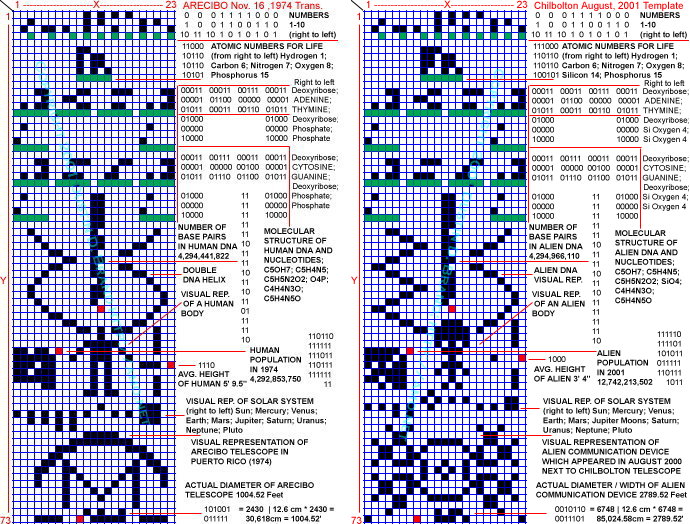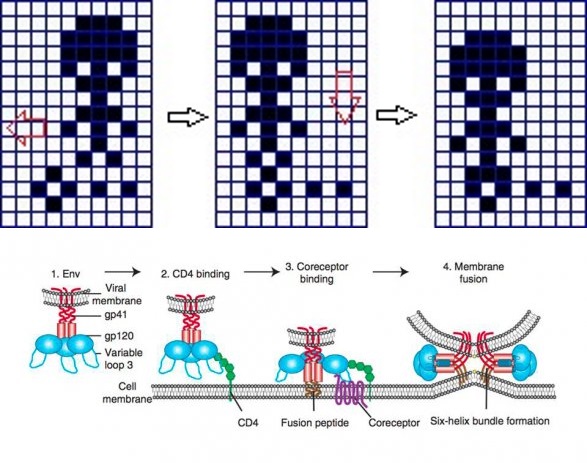
|
Of promises broken David Gilmour. Pink Floyd. "Sorrow" |
How do some methods of evolution, used in the emergence of multicellular organisms may result in failure of the immune system? What kind of diseases can this lead to? Virus of an immune upgrade HIV++ and its estimated functions. Hypothesis of extraterrestrial origin of the virus of immune upgrade. Interpretation of Chilbolton field drawings of 2000-2002, as a presentation of the HIV++ virus, its purpose and basic properties. Whether it is possible to find and sequence the HIV++ virus?
Evolution methods leading to immune system problems
The emergence of multicellular organisms in the process of evolution involved mechanisms that anyway while protecting from foreign and malignant formations should have led to problems in the immune system. But, if the problem lies in the very basis of the design of the immune system and fundamentally cannot be corrected by simple methods, the only way to fix the problem should be the emergence of qualitative new principles for building the immune system, that is, its upgrade to a new level. Let's consider some examples.
Oncology
Ordinary somatic cells of vertebrates are devoid of telomerase activity, however, when stem cells are divided, for example, during development of the embryo, it becomes necessary to finish the ends of chromosomes after each division of the cell, which leads to circumvention of the Hayflick limit and theoretically allows the cells to multiply endlessly, remaining always young. This mechanism can lead to the appearance of malignant formations that declared their independence from the main organism and also wished to multiply unlimitedly. The function of telomerase is borrowed from retroviruses. In the mammalian genome, there is a gene necessary for the development of the placenta with the help of which the embryo explains to the mother's body that its development should be promoted in every possible way. The structure of this gene is similar to the structure of one of the mobile-genetic elements, that is, it is also a retrovirus retrovirus accepted for service by a multicellular organism. A cancer cell uses both mechanisms in its life activity, and the immune system is not able to resist it, because the tumor speaks their common language. The immune system itself is also set of principles and communication protocols that came into the body from the time of the appearance of multicellular organisms: the mechanism of interaction chemokines-receptors as the 'whole package' was inherited from the communication of the simplest.
Tuberculosis and leprosy
Macrophages and monocytes for fighting with foreign entities use the methods of unicellular bandits such as amoebas. Phagocytosis arose as a further improvement in the predation lifestyle of unicellular organisms. The ingestion of foreign bacteria while satisfying macrophage's personal ambitions, also serve the task of protecting the whole organism. However it turns out that in some cases momentary interests become higher than the global ones. Some classes of diseases can exist only through the support and protection of macrophages. Phages save from the immune system plague and anthrax. You need to recall tuberculosis and leprosy. As studies show, in phagocytic cells there can be a large number of M. tuberculosis and M. leprae bacteria and this does not affect the course of the disease in any way. The macrophage can support the existence of leprosy bacteria in vitro conditions for weeks. A single phagocytic cell 'negotiates' with the bacterium about mutually beneficial coexistence: the macrophage covers the bacterium in order not to be destroyed by the immune system. This is similar to the conclusion of a treaty between the police and crime, bypassing the general state interests. But in this way mitochondria, the Golgi apparatus, chloroplasts and other organelles arose.
AIDS
The HIV virus itself cannot cause AIDS. Observations show that in the last stage of AIDS, when there are less than 200 CD4+ T-helper cells per mm3 in the blood, only 0.1% of all T-helpers, that is, 1/1000 cells, are infected. The mass death of CD4+ cells cannot be explained by the viral load of HIV: the virulence of HIV is by no means the result of its massive replication. Moreover, in sooty mangabeys, Cercocebus atys, the development of SIV infection does not lead to damage to the cells of the immune system, although it is accompanied by the same viral load as HIV in humans. Hence, Cercocebus atys avoid the development of the disease, not by controlling the replication of the retrovirus, but by the absence of a pronounced response to the virus from the immune system. The host's metabolic costs for HIV replication are not sufficient to provoke the disease. Hence the paradoxical conclusion: a person falls ill with AIDS not because he is infected with HIV, but because his body begins to fight against the virus. If the human immune system ignored HIV, then no disease would arise. The case of Cercocebus atys is an exception to the rule, but no one has yet figured out why it occurs. All this suggests that AIDS caused by HIV is a consequence of internal problems in the immune system, resulting from general failure of system design. This is tantamount to internal showdown within the law enforcement agency, when one department begins to fight with another for a minor reason.
Drug addiction
There is a problem with protecting the body from chemicals that have an affinity for sensory receptors, primarily to opioid receptors. The incentive system of the 'pleasant-unpleasant' type works through the generation of neurotransmitters capable of affecting the nerve endings by sending certain signals to the central nervous system. For 'joy' responsible serotonin, for 'pleasure' — dopamine. Endogenous, that is, internal opiates — endorphins are responsible for 'euphoria.' Physiologically, endorphins and enkephalins have the strongest analgesic, anti-shock and anti-stress action while reducing the sensitivity of individual parts of the central nervous system. Euphoria from viewing works of art or listening to music has also an endorphinous nature. The reason for the popularity of sports is not only in the cult of strength, but also in the release of endorphins, which occurs when the stress load stops. Excitation of the nervous system during sexual activity in animals is caused by regular internal synthesis of sex hormones. Unlike animals, a person can deceive the incentive system and artificially synthesize the right substance to obtain the desired effect. The emergence of physical dependence on such substances must also be called an inherent defect of the defense system. A clear enemy, leading to death, is considered by the body as a 'close friend'. The immune system is not capable of producing antibodies against nicotine or opium. This is similar to situation when the drug dealer pays the police: the more drug addicts and drug dealers, the better the police live.
In all these cases, foreign elements find ways to 'negotiate' with the body's defense system at a 'personal level', to the detriment of the vitality of the organism as a whole. Such shortcomings of the immune system cannot be eliminated in simple ways. It is necessary to have a mechanism for monitoring the immune system itself. Such systems are not observed today in nature. If a cancerous tumor convinces host organism to help itself: to bring blood vessels and other resources to it without regard to other organs, then there is no any mechanism to talk some sense into to the immune system. If the macrophage stands up for the protection of a tubercle bacillus or leprosy, then who will be the judge? How to explain to the immune system that in the case of HIV T-helpers are by no means 'enemies of the people' and any immune response to HIV destroys the immune system? How to explain to cells that dopes having an affinity for opioid receptors is actually a cold-blooded killer? If we are faced with the task of inventing a mechanism, which simply and effectively solves the problem of 'rotten friends', how can this be done at all?
How the immune system could be improved?
The system of protection that can be discussed first of all should be a superorganism: a set of separate independent components that form an integral whole. Self-consistent superorganism produce actions that are collectively managed and involve the division of labor based on the specialization of individuals. Each member of the superorganism must be able to sacrifice itself for the overall survival. A typical example of such a system is a bee or ant family. Despite the existence of a division of labor and the specialization of individual cells, the human immune system is not a superorganism. The cancer tumor, on the contrary, has the properties of a superorganism: acting as a whole against a set of individual immune cells, it has a significant advantage. If the immune system was a single whole such diseases as cancer, tuberculosis or HIV would never arise.
Let us consider a historical analogy. When individual Central Russian principalities were united by Ivan III into the Moscow state, a kind of multicellular organism arose, where individual parts still remembered the time when they were free and independent. In such a system, the federal interests could be neglected without major problems and any ally is a potential enemy. On the defense of the Moscow state there were former bandits who, under convenient conditions, were able to act both against the central authorities and against each other. There was no federal defence system that consider the interests of the state as a whole above the interests of the princes who had not yet forgotten their 'independent past'. In such a situation, to strengthen the mechanism of central administration, Ivan IV the Terrible created the 'oprichnina' — the first example of a system for protecting state security in Russia. To strengthen his power he often had to cross through 'other obstacles', using executions, torture and repression and his policy was generally unpopular. But if the task is to destroy a cancerous tumor in order to survive, does not the purpose justify the means?
To defeat foreign pathogens and one's own malignant cells, the immune system must have a replenished, unique for Homo sapiens species and transferable from person to person database. A direct analogue is the database created at the National Center for Biotechnological Information NCBI. The appeal of the immune system to such a database should have a strictly advisory nature just for the initial impetus to a more detailed study of the situation. Information about pathogen or substance caused a problem found in one individual should be available to the immune systems of all people, and not necessarily to induce an immune response to this pathogen or substance. In each case immune defense should adjust pathogen information individually. At present, immunity cannot be transferred from one person to another: the information of memory cells is ignored by the principle of the main histocompatibility complex filter, and the immune cells live in a foreign body from several hours to several days. Vaccination from smallpox or flu must be done every time anew. In addition, vaccination sometimes is hampered by the effect of 'original antigenic sin': when a new strain of the pathogen occurs, the body produces antibodies to the old one. How could evolution actually implement upgrade of immunity for an effective fight with 'rotten friends', which requires the creation of a superorganism from immune cells that has an advisory function based on a database specific for the Homo Sapiens species?
The human genome is at least 45% composed of retrotransposons, mobile genetic elements. The role of retroviruses in evolution can be demonstrated by the example of the emergence of an adaptive immune system in jawbones about 500 million years ago. To form various antibodies, the cells of the immune system change the DNA sequence by somatic recombination using a system that has arisen and evolved due to the mobile elements of the genome. Thus, it can be assumed that to upgrade the immune system, retroviruses will be used. In order to create a superorganism, these retroviruses must also study some features of oncoviruses. Such a smart HIV virus, who has risen to protect human health may become an ultimate weapon against most incurable diseases.
The existence of edible fly agarics is noteworthy: Amanita rubescens look awesome, like real poisonous grebe, however in contradistinction to all its relatives, the gray-pink fly agaric is safe and very palatable, although it is recommended to boil it before consumption. For an usual eye, the edible Amanita rubescens resembles a deadly poisonous panther fly agaric, Amanita pantherina, and therefore mushroom pickers rarely collect these mushrooms. The effect found in sooty mangabeys, Cercocebus atys, when the development of infection does not results in failure of the immune system, proves the theoretical possibility of the existence of nonpathogenic HIV viruses. Organism positively relates to friendly organisms that help it in life: antibodies against the intestinal microflora, never arises. If HIV did not cause the appearance of antibodies, it would ever hardly have been noticed.

Edible fly agarics Amanita rubescens.
The viruses that caused the AIDS pandemic in this context should resemble Khlestakov from Gogol's play 'The Inspector General', and their only purpose may be to encourage the scientific world to spend billions of dollars to understand molecular biology. Studies of the HIV virus have shown that some proteins even have evolved in the direction of supporting this retrovirus. Hence, evolution do expects the appearance of a virus morphologically similar to HIV as a savior for carrying out an immune upgrade, 'the Real Inspector'. The APOBEC3 protein helps spread HIV in humans by compensating for backward translation errors in the vif gene. Mice with destroyed APOBEC3 are phenotypically unchanged, which indicates that this protein does not have a relation to the functioning of the mammal itself. The TRIM5Alpha protein is able to successfully eliminate retroviruses other than HIV and is completely helpless against HIV itself. The versions of the gene expressing this protein in monkeys have a mutation that would never allow HIV to spread. It turns out that when the anthropoid apes appeared several million years ago, evolution transformed the TRIM5Alpha protein in such a way that in the 20th century it would help to support the AIDS pandemic and may be also a savior from it...
The immune upgrade virus HIV++.
But how does a virus morphologically reminiscent of HIV, call it HIV++, could practically strengthen a person's immunity? HIV infects only cells of the immune system and only those cells that have a special CD4 receptor along with additional chemokine co-receptors CCR5 or CXCR4. This condition is very strict. The only 'cured from AIDS patient' had a transplanted bone marrow from donor with a genetic mutation of the CCR5 co-receptor. If HIV++ uses the properties of oncovirus it is capable to 'disconnect' the cell from the main system and make it part of superorganism subsystem, that is turn off the main histocompatibility complex filter.
The CD4 receptor is possessed by monocytes, macrophages, Langerhans cells, dendritic cells, that is, those that possess an antigen-presenting function. Their task is to absorb the pathogen and present pathogen's antigenic determinant, epitope, on a membrane. CD4 is also present in T-helpers — cells that read information from antigen presenting cells in the main type II histocompatibility complex protein, peptides synthesized for the recognition of pathogen patterns. Together with antigen-presenting cells, T-helpers form a functionally closed system. The activity of this system leads to the creation of a pathogen database, recorded on T-memory cells. HIV++ could enhance this database my making it independent of a particular organism, replenished, and easily transmitted from person to person. If the closed immune subsystem exists completely independently as an 'alien friend', one can expect to get from it the most objective reflection of the situation, which is necessary for an effective fight against 'rotten friends', that is, enemies building themselves as friends.
The microglial cells, resident macrophages of the central nervous system, also have CD4 receptors. These cells located behind the blood-brain barrier, where access is forbidden even to lymphocytes, although HIV can freely penetrate there. This seems strange. If we assume that the CD4 receptor exists specifically to create an autonomous immune information subsystem, then why there are cells in this system playing an insignificant role in the fight against infectious agents? Microglia cells are able to control contacts between nerve cell synapses and, consequently, to become a mechanism for regulating the response of the organism to increased affinity of chemicals to nerve receptors including opioid receptors. Hence, becoming a part of the described immune superorganism, microglia cells may control the occurrence of physical dependence to sensory receptor agonists or, at least, place such chemicals in the database of especially dangerous pathogens. It turns out from the above that the CD4 receptors on microglia cells exist in order to fight drug addiction.
If the appearance of the immune upgrade virus was expected and supported by evolution, this explains the properties of proteins APOBEC3 and TRIM5Alpha. The specificity of such a virus to CD4 receptors severely limits the scope of its activity to an advisory voice for information purposes only. CD4+ cells are not capable of killing anyone, but may only suggest an optimal defense strategy. By making up no more than 1/1000 of the entire immune system, this autonomous subsystem may be able to maintain an independent and replicable database of all pathogens specific for the Homo Sapiens species.
Consider how HIV++ virus, morphologically similar to HIV, could transmit information about pathogens from one cell to another. The usual memory T-cell contains several thousand antigen-presenting molecules on its surface, but they are all the same. When HIV buds from the cell membrane, it takes with it a small piece of this membrane. This piece contains a small portion of information from the pathogen database and virus transfers this information to another memory cell. As a result, each memory cell will carry complete information about all pathogens at the same time, which should increase the sensitivity and response rate of the pathogen recognition system by several thousand times.
When the blood of a person with such an advanced immune system created by HIV++, is transfused into another, the immune upgrade virus will transfer a database of pathogens to a new organism. A cell infected with a virus is immediately disconnected from the main organism and becomes part of a new autonomous immune system, superorganism, for which there is no prohibition on the filter of the main histocompatibility complex. As a result, all information freely and unimpeded copied from one person to another. Transition of T-helper cells to the immune subsystem is fully sanctioned by the main immune system — HIV enters the nucleus of only activated lymphocytes.
It is not known exactly where and how HIV-1 and HIV-2 viruses originated, but their existence was determined by studying the diseases they cause. On the contrary, if there is a virus HIV++, protecting from a number of diseases, then finding it is much more difficult. How to find something that manifests itself not in existence, but in the absence of problems: a person will never complain to the doctor that he is never become sick. In addition, such a symbiotic virus may include a special design for effective self-protection against unauthorized use, which can significantly complicate its finding and identification. The virus-symbiont will not cause an immune reaction, antibodies will never be produced and any test for known antibodies will give a negative result.
RNA allows two alternative ways of linking nucleotide bases to the 5'-3' ends and the 5'-2' ends. In E. coli, there is a 5'-2' RNA ligase creating such a geometry in vivo. In mammals, an RNA polymerase that would create RNA with an alternative 5'-2' linkage was not found, although there is an interferon RNAase L that actively kills (nonexistent) 5'-2' RNA, so 5'-2' HIV++ virus if necessary may be easily exterminated by the host cell for any unfriendly action. To create such a geometry the HIV++ virus may possess a gene, encoding an alternative 5'-2' RNA-polymerase. The traditional methods of PCR are not applicable to molecules with 5'-2' geometry, therefore cultivation and sequencing of such a non-standard molecule could be difficult. DNA and RNA purely biophysically allow the replacement of phosphate PO4 with silicon tetroxide SiO4, however no one silicon DNA was so far found on Earth. If the goal is to completely isolate the autonomous immune system from the entire microbiological system of the planet, one cannot think of a better option. Such a structure allows to forget about PCR and genetic engineering completely.
As a result of recent studies of the genome of 2500 people, using the results of the 1000 Genomes Project, 19 people were found to possess fully preserved endogenous HERV-K virus of the HML2 subtype. This is the second such virus after the famous HERV-K113. Nothing forbids the existence of endogenous 'reference HIV++ virus', recorded on the germline DNA and transmitted by inheritance. Awakening of such a virus makes it possible to transmit itself from person to person. Obviously, the genes of endogenous HIV++ must necessarily be expressed in the thymus and therefore, no lymphocyte specific for such a virus will ever arise.
Hypothesis of extraterrestrial origin of the virus of immune upgrade.
The phenomenon of the appearance of crop formations is subjected to severe criticism and still there is no understanding of how they are created. In 2000-2002, there were reports of drawings, which were interpreted by many as of extraterrestrial origin. Message received not with radio signals from distant galaxies, but in the form of pictures in the fields, implies that 'extraterrestrial intelligence' is located somewhere on Earth. If this alien entity is able to interfere with crop growth on the field, it is possible that it's this alien who is able to create HIV++ virus and present the immune upgrade to people. One of the interpretations of the Chilbolton phenomenon is that it is an overview of the HIV++ virus and some of its properties.
August 13, 2000 on the field near the radio telescope in Chilbolton appeared image 'Fractal':

The image of "Fractal" in front of a radio telescope.
On August 14, 2001, the image of the human 'Face' appeared on the same field, which could be viewed only from one specific angle. The technical execution of the 'Face' fully proves its 'extraterrestrial origin', as no earth technology is able to create today something like that.

Image of "Face" in the Chilbolton field.
On August 20, 2001, appeared the 'Message' very reminiscent of a message sent to space on November 16, 1974 from the radio telescope of the Arecibo Observatory in the direction of the star cluster M13.


"Message" on the Chilbolton field and its orientation with respect to the radio telescope.
August 15, 2002 on the field of Sparsholt near Winchester appeared the image of the 'Alien' along with the disk on which in English, in the standard ASCII encoding, was written the message:
'Beware the bearers of FALSE gifts&their BROKEN PROMISES. Much PAIN but still time. EELRIJUE. There is GOOD out there. We OPpose DECEPTION. Conduit CLOSING [bell sound]'

The image of the "gray" "Alien" with a computer CD.
If 'Fractal', 'Person' and 'Message' were oriented around the radio telescope of distant space communication, and the 'Message' was strictly directed to the telescope plate, then the axis of the 'Alien' is aimed at the cellular tower, that is local communication.
On August 28, 2002, the last picture, recorded in 2002 on a wheat field in Crooked Soley, Berkshire, showed a DNA wrapped in a ring, 'DNA ring' that had 6 base pairs per turn. Ordinary DNA, coiled into a spiral, has 10 base pairs per turn.

DNA strand folded into a ring, with 6 pairs of bases per turn.
So, the following pictures are supposedly related to the announcement of a new immune system:
- Fractal (August 13, 2000)
- Face (August 14, 2001)
- Message (20 August 2001)
- Alien (August 15, 2002)
- DNA-ring (August 28, 2002)
- Stacking of plants was carried out in several layers, each of which was twisted in the opposite direction from the previous one.
- Stems had no visible damage, were not broken, just bent at different angles.
- The presence of microscopic holes on the stems of wheat in the zones of 'crease' caused a partial loss of the bearing capacity of the stem.
- Because of these holes, the metabolism in the plant, although not stopped, but the plant itself has never matured and remained green forever.
- The sophisticated 'pixel' technique allowed to form a complex image with semitones.
- Laboratories revealed in plants genetic changes.
Correlation between the Chilbolton 'Message' and the message sent in 1974 from the Arecibo Observatory is very high.

Chilbolton "Message" in comparison with the message of the radio telescope Arecibo.
All these drawings are directly related to each other, forming one mosaic structure. 'Fractal' is a larger and more detailed image of the object at the bottom of 'Message'. 'DNA' with 6 pairs of bases per turn on the left side of 'Message' is repeated on 'DNA ring'. The image of the 'gray' 'Alien' with the CD disk, voices the whole composition and is an enlarged image of the men's head in the center of 'Message'. The face, divided by strip from tractor into two parts, corresponds to two parts of the DNA, divided by a vertical strip with the number of base pairs.
There are many descriptions, analyzes and interpretations of all these drawings. A good analysis can be found in Richard Hoagland's article 'A message finally received'. No one has yet suggested the connection of the Chilbolton messages with the HIV virus, and therefore if such a connection takes place, this once again proves the extraterrestrial nature of the message. In the 'Alien' message there is a sentence 'There is GOOD out there'. Those to whom English is native may note that colloquial phrase 'out there' is a strange give-away. Why did someone need to use English slang in the message? The general parodic character of the whole picture of 'Alien' speaks of the existence of figurative associations between the text of 'Alien' and famous products of mass culture. Thus, the phrase 'BROKEN PROMISES' may be associated with the composition of Pink Floyd 'Sorrow' from the disk 'Momentary lapse of reason', and 'bell sound' with the disc 'Division Bell' of the same rock group. The hospital motif of the album cover of 'Momentary lapse of reason' is quite correlated with the HIV pandemic theme:

Pink Floyd album cover "Momentary lapse of reason".
The phrase 'out there' refers to the main slogan of the American TV series 'The X-files': 'The truth is out there'. The main theme of this series describes certain 'alien genes' that can save the Earth from virus epidemics and the existence of some secret government conspiracy wishing to use these genes to seize control of mankind. Several episodes of 'The X-files', released in the autumn of 1999 in the sixth and seventh seasons, right before the emergence of painting on the crop fields ('Biogenesis' and 'Sixth Extinction'), tell about several plates with unknown symbols that could be combined with each other in the form of a mosaic. Agent Scully discovered, that the information on these tablets is related to molecular biology, and the alien genes were implanted to Agent Molder. In the recent 10th season, episodes entitled 'My Struggle' (with a hint of 'Mein Kampf') show that the alien genes were implanted to Agent Scully. It turns out that in response to the slogan that 'The truth is out there', 'Alien' from the wheat field jokes that 'The X-files series is also somewhere GOOD'.

Agent Scully from the series "X-Files". Episode "My Struggle".
The phrase 'Beware the bearers of FALSE gifts and their BROKEN PROMISES.', that is, 'Be afraid of the Danaians gifts of the bringers' means the main goal of the immune upgrade — the war with 'rotten friends': oncology, tuberculosis, AIDS, drug addiction and so on. The same goes for the phrase 'We OPpose DECEPTION': each of these 'rotten friends' somehow engaged in a scam, deceiving the immunity. The word OPpose divided into two parts: OP-pose, so the 'Alien' op-poses the posed (by whom?) scam mechanism.
In Arecibo's message of 1974, the little man is above the point, which stands for the third planet of the Solar System, that is, the Earth. In the Chilbolton 'Message' a certain figure with a huge head and small legs stands above the three planets. An analogy can be drawn with the mechanism by which HIV enters the CD4+ cell of the lymphocyte. The CD4 receptor, a transmembrane glycoprotein, consists of three parts, which exactly repeats the pattern of the 'three planets': four extracellular domains, a transmembrane domain and a cytoplasmic region. Four extracellular domains correspond to the rhombus on the 'Message'. Earlier it was assumed that the rhombus should correspond to the four main satellites of Jupiter. With the help of a protein gp120 on the surface, HIV finds a CD4 receptor of the cell and firmly attached to it by the key-lock principle. This can be easily demonstrated. If a small man with a large gray head is an HIV++ virus, then his two eyes and some parts of the 'Message', that are different from the Arecibo message should relate to the two strands of its viral RNA.

The HIV virus enters the CD4+ cell.
A set of elements at the top of 'Message' is supplemented by silicon. Most analyzers boil down to the idea that extraterrestrial DNA contains silicon tetraxide SiO4 instead of phosphate PO4. Since the head of the virus in the picture corresponds to the image of 'Alien', we are talking about the fact that the strands of HIV++ RNA should have in their structure silicon instead of phosphorus. It is also possible that the geometry of the HIV++ RNA strands may not be 5'-3', but 5'-2'. The study of the 5'-2' geometry, however, does not show large differences from 5'-3'. The Chilbolton 'Message' depicts two DNA molecules: the usual one on the right with ten pairs of bases per turn, and another on the left with six pairs of bases per turn. It is possible that this geometry is caused not by a change from 5'-3' linkage, to 5'-2', but by substitution in the RNA structure of phosphate PO4 by silicon tetraoxide SiO4, although there may be both. 'DNA-ring' shows a DNA strand with six bases on the turn in the form of a ring. It is known that before inserting into the nucleus of the cell, the virus strand is folded into a ring, so obviously it is a question of the virus, having unconventional geometry.
The line dividing the two DNA molecules in the Arecibo message relates to the length of human DNA, expressed in terms of the number of base pairs. In the Chilbolton 'Message', one empty cell is changed to a full one. This may mean not the difference in the number of base pairs in extraterrestrial DNA, but simply the fact that the alien virus HIV++, entering the nucleus of the cell, occupies a free space there, without interfering with any important genes. The same can be said if we are talking about the endogenous version of the virus of the immune upgrade.
At the bottom of the message from Arecibo in 1974, was schematically drawn a radio telescope plate with the help of which a message was sent: a mechanism for transmitting information. The Chilbolton 'Message' in the same place has something that is depicted more detailed in the image 'Fractal' from 2000. Apparently, this 'Fractal' explains the principle of creating a database of pathogens with the help of autonomous immune cells. Once the T cell is activated, it begins to divide to find the best approximation to the epitope of the pathogen. This symbolizes the sequence of large circles. When the algorithm for epitope pattern recognition finds the best approximation, the information found is written to the new memory cell. This may be symbolized on picture by a chain of small circles. This sequence of operations is similar to the classification of some protein using the BLAST program followed by entering the found information into the database. Now this information is stored indefinitely and can be transmitted from person to person, as an immune T-cell analog of NCBI GenBank record. 'Fractal' as a whole may also represent a single T-memory cell, that is definitely a mechanism for transmitting information.

Sample NCBI GenBank record.
It is important to emphasize that the HIV virus is allowed to enter the nucleus of the T-helper cell strictly after it is activated: that is, after a real epitope of the pathogen is found and the body's basic immune system has allowed to activate the adaptive mechanism of T-lymphocytes. This sequence of events should exclude the entry into the T cell memory database such results, which have nothing to do with the real pathogens.
The image of the Chilbolton 'Face' can be well discernible only under a special acute angle of view and only under a special angle of sunlight. In order to obtain such an unusual effect, advanced methods of drawing were used on the field, completely excluding the possibility of creating such a drawing by people.
The special technique of creating 'Face' may indicate the strictly extraterrestrial, artificial nature of HIV++, so the version of terrestrial origin of HIV++ would have been initially discarded. There are no silicone DNA on Earth. This should also demonstrate the fact that it is not so easy to detect and identify the presented virus: its structure is designed to protect the product from any interference with living organisms, including humans. The possibility of genetic modification of alien genes with incompatible transcriptase and polymerase is fundamentally excluded.
The last step is to find and decipher the DNA of the HIV++ virus. Chilbolton 'Face' is divided into two parts. The left part is mapped to a RNA strand with nontraditional geometry, the genetic basis of HIV++ when it exists freely, in the form of a virion. The right side of the face is mapped onto the most common DNA strand — like one in the Arecibo message and should be related to to the HIV++, when its genetic information is recorded on the chromosome of the cell. Complete sequencing of the infected DNA cells is difficult — try to find them. The endogenous type of HIV++ can be found in a standard way, resembling HERV-K113, but it is possible that HIV++ has some protection against simple deciphering and ordinary methods will miss it. One may simply look with the electron microscope and try to see HIV++ optically, as the HIV-1 was originally found, but with a viral load of less than 1/1000 and low viral activity, it can take a very long time, and therefore may require significant funding.